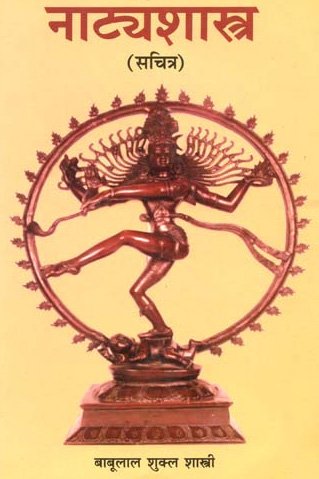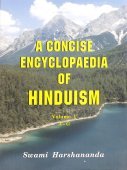Khandana, Khaṇḍana, Khamdana: 20 definitions
Introduction:
Khandana means something in Hinduism, Sanskrit, Buddhism, Pali, Marathi, Jainism, Prakrit, Hindi. If you want to know the exact meaning, history, etymology or English translation of this term then check out the descriptions on this page. Add your comment or reference to a book if you want to contribute to this summary article.
In Hinduism
Natyashastra (theatrics and dramaturgy)
Source: Wisdom Library: Nāṭya-śāstraKhaṇḍana (खण्डन, “grinding”) refers to a specific gesture (āṅgika) made with the chin (cibuka), according to the Nāṭyaśāstra chapter 8. These gestures form a part of the histrionic representation (abhinaya).
Source: archive.org: Natya ShastraKhaṇḍana (खण्डन).—A type of gesture (āṅgika) made with the chin (cibuka);—Instructions: when (the two lips) repeatedly come together with each other. Uses: in muttering mantras (japa), studying, speaking and eating.

Natyashastra (नाट्यशास्त्र, nāṭyaśāstra) refers to both the ancient Indian tradition (shastra) of performing arts, (natya—theatrics, drama, dance, music), as well as the name of a Sanskrit work dealing with these subjects. It also teaches the rules for composing Dramatic plays (nataka), construction and performance of Theater, and Poetic works (kavya).
Shaivism (Shaiva philosophy)
Source: Brill: Śaivism and the Tantric Traditions (philosophy)Khaṇḍana (खण्डन) refers to “annihilation (of ordinary human practice)”, according to Utpaladeva’s Vivṛti on Īśvarapratyabhijñākārikā 1.5.6.—Accordingly, “[...] [If you reply:] “But this [property of being an object] can only belong to [things] that are distinct from manifestation,” what [of these objects] could there be [if they are distinct from manifestation]? [And] what is this [so-called] annihilation of ordinary human practice (vyavahāra-khaṇḍana) [that must inexorably occur according to you] if [objects] are one with phenomena? This is what [the Vṛtti] says in “let [us admit that] they consist in phenomena. [...]”.

Shaiva (शैव, śaiva) or Shaivism (śaivism) represents a tradition of Hinduism worshiping Shiva as the supreme being. Closely related to Shaktism, Shaiva literature includes a range of scriptures, including Tantras, while the root of this tradition may be traced back to the ancient Vedas.
Purana and Itihasa (epic history)
Source: archive.org: Shiva Purana - English TranslationKhaṇḍana (खण्डन) refers to “ridiculing” (the Vedas), according to the Śivapurāṇa 2.5.3 (“The virtues of the three cities—Tripura).—Accordingly, after Viṣṇu thought of ways to destroy the Asuras in the Three Cities.—“[...] Deciding thus, Viṣṇu started ridiculing (khaṇḍana) the Vedas [śruti khaṇḍanam] for putting up obstacles in the virtuous activities of the Asuras. At the bidding of Śiva, Viṣṇu who was commanded to protect the three worlds, and who renders help to the gods spoke to them”.

The Purana (पुराण, purāṇas) refers to Sanskrit literature preserving ancient India’s vast cultural history, including historical legends, religious ceremonies, various arts and sciences. The eighteen mahapuranas total over 400,000 shlokas (metrical couplets) and date to at least several centuries BCE.
Languages of India and abroad
Pali-English dictionary
Source: BuddhaSasana: Concise Pali-English Dictionarykhaṇḍana : (nt.) breakage.

Pali is the language of the Tipiṭaka, which is the sacred canon of Theravāda Buddhism and contains much of the Buddha’s speech. Closeley related to Sanskrit, both languages are used interchangeably between religions.
Marathi-English dictionary
Source: DDSA: The Molesworth Marathi and English Dictionarykhaṇḍaṇa (खंडण).—n khaṇḍaṇā f (Corr. from khaṇḍana S) Breaking. 2 fig. Confuting.
--- OR ---
khaṇḍana (खंडन).—n (S) Breaking. 2 Shattering, smashing, destroying, lit. fig. 3 Interrupting. 4 fig. Confuting. Ex. of comp. vādakhaṇḍana, matakhaṇḍana, granthakhaṇḍana, abhimānakhaṇḍana, mānakhaṇḍana.
--- OR ---
khāndāna (खांदान).—m f ( P) Family, parentage, stock, race. khāndānīcā Of a good family, noble, genteel. Also written khānadāna. 2 fig. Clever, sharp, smart--a kārakūna, śipāī &c.
Source: DDSA: The Aryabhusan school dictionary, Marathi-Englishkhaṇḍana (खंडन).—n Breaking; interrupting. Fig. Confuting.
--- OR ---
khāndāna (खांदान).—m f Family, parentage.
Marathi is an Indo-European language having over 70 million native speakers people in (predominantly) Maharashtra India. Marathi, like many other Indo-Aryan languages, evolved from early forms of Prakrit, which itself is a subset of Sanskrit, one of the most ancient languages of the world.
Sanskrit dictionary
Source: DDSA: The practical Sanskrit-English dictionaryKhaṇḍana (खण्डन).—a. [khaṇḍ-lyuṭ]
1) Breaking, cutting, dividing.
2) Destroying, annihilating; स्मरगरलखण्डनं मम शिरसि मण्डनम् (smaragaralakhaṇḍanaṃ mama śirasi maṇḍanam) Gītagovinda 1; भवज्वरखण्डन (bhavajvarakhaṇḍana) 12.
-nam 1 Breaking or cutting.
2) Biting; injuring, hurting; अधरोष्ठखण्डनम् (adharoṣṭhakhaṇḍanam) Pañcatantra (Bombay) 1; घटय भुजबन्धनं जनय रदखण्डनम् (ghaṭaya bhujabandhanaṃ janaya radakhaṇḍanam) Gītagovinda 1; Ch. P.12; दर्शनेन कृतखण्डनव्यथाः (darśanena kṛtakhaṇḍanavyathāḥ) R.19.21.
3) Disappointing, frustrating (as in love).
4) Interrupting; रसखण्डनवर्जितम् (rasakhaṇḍanavarjitam) R.9.36.
5) Cheating, deceiving.
6) Refuting (in argument); N.6.113.
7) Rebellion, opposition.
8) Dismissal.
Source: Cologne Digital Sanskrit Dictionaries: Shabda-Sagara Sanskrit-English DictionaryKhaṇḍana (खण्डन).—n.
(-naṃ) 1. Breaking, dividing, cutting, reducing to pieces. 2. Destroying, annihilating. 3. Refuting, (in argument.) 4. Rebellion, opposition. E. khaṇḍ to break, lyuṭ aff.
Source: Cologne Digital Sanskrit Dictionaries: Benfey Sanskrit-English DictionaryKhaṇḍana (खण्डन).—[khaṇḍ + ana], I. adj., Destroying, [Gītagovinda. ed. Lassen.] 10, 8. Ii. n. 1. Hurting, [Pañcatantra] 45, 11. 2. Violation, [Pañcatantra] 46, 3. 3. Deceiving, baffling, [Hitopadeśa] ii. [distich] 58.
Source: Cologne Digital Sanskrit Dictionaries: Cappeller Sanskrit-English DictionaryKhaṇḍana (खण्डन).—[adjective] breaking to pieces, destroying, removing, [neuter] the act of breaking etc., also wounding, injuring, interrupting, frustrating, refusing, cheating, deceiving.
Source: Cologne Digital Sanskrit Dictionaries: Aufrecht Catalogus Catalogorum1) Khaṇḍana (खण्डन) as mentioned in Aufrecht’s Catalogus Catalogorum:—vedānta. Oppert. Ii, 3913. 4545.
—by Bhīṣmamiśra. Kh. 88.
2) Khaṇḍana (खण्डन):—vedānta. Inaccurate title. Hz. 1265.
Source: Cologne Digital Sanskrit Dictionaries: Monier-Williams Sanskrit-English Dictionary1) Khaṇḍana (खण्डन):—[from khaṇḍ] mfn. ifc. breaking, dividing, reducing to pieces, destroying, annihilating, removing, [Gīta-govinda]
2) [v.s. ...] n. the act of breaking or cutting or dividing or grinding, [Hitopadeśa]
3) [v.s. ...] hurting, injuring ([especially] with the teeth), [Pañcatantra; Kathāsaritsāgara ciii; Gīta-govinda; Caurapañcāśikā]
4) [v.s. ...] interrupting, disappointing, frustrating, [Mālavikāgnimitra; Raghuvaṃśa; Pañcatantra] etc.
5) [v.s. ...] refuting (in argument), [Horace H. Wilson]
6) [v.s. ...] cheating, deceiving, [Raghuvaṃśa xix, 21; Hitopadeśa]
7) [v.s. ...] rebellion, opposition, [Horace H. Wilson]
8) [v.s. ...] = khaṇḍana-khaṇḍa-khādya, [Naiṣadha-carita vi, 113]
9) Khaṇḍanā (खण्डना):—[from khaṇḍana > khaṇḍ] f. discarding, dismissal, [Sāhitya-darpaṇa]
Source: Cologne Digital Sanskrit Dictionaries: Yates Sanskrit-English DictionaryKhaṇḍana (खण्डन):—(naṃ) 1. n. Breaking; opposition; refutation.
Source: DDSA: Paia-sadda-mahannavo; a comprehensive Prakrit Hindi dictionary (S)Khaṇḍana (खण्डन) in the Sanskrit language is related to the Prakrit words: Khaṃḍaṇa, Khaṃḍaṇā.
[Sanskrit to German]
Sanskrit, also spelled संस्कृतम् (saṃskṛtam), is an ancient language of India commonly seen as the grandmother of the Indo-European language family (even English!). Closely allied with Prakrit and Pali, Sanskrit is more exhaustive in both grammar and terms and has the most extensive collection of literature in the world, greatly surpassing its sister-languages Greek and Latin.
Hindi dictionary
Source: DDSA: A practical Hindi-English dictionaryKhaṃḍana (खंडन) [Also spelled khandan]:—(nm) refutation, rebuttal, repudiation; denial, —[maṃḍana] repudiation and vindication; discussion for and against; [khaṃḍanātmaka] repudiative, causing or embodying refutation/rebuttal/denial.
...
Prakrit-English dictionary
Source: DDSA: Paia-sadda-mahannavo; a comprehensive Prakrit Hindi dictionary1) Khaṃḍaṇa (खंडण) in the Prakrit language is related to the Sanskrit word: Khaṇḍana.
2) Khaṃḍaṇā (खंडणा) also relates to the Sanskrit word: Khaṇḍanā.
Prakrit is an ancient language closely associated with both Pali and Sanskrit. Jain literature is often composed in this language or sub-dialects, such as the Agamas and their commentaries which are written in Ardhamagadhi and Maharashtri Prakrit. The earliest extant texts can be dated to as early as the 4th century BCE although core portions might be older.
Kannada-English dictionary
Source: Alar: Kannada-English corpusKhaṃḍana (ಖಂಡನ):—
1) [noun] the act or an instance of breaking (into fragments).
2) [noun] the act of barring, hindering the progress of; obstruction; impedement.
3) [noun] the act of refuting or proving false or wrong; disproof; refutation.
--- OR ---
Khaṃḍāna (ಖಂಡಾನ):—[noun] a man who proves the falsity or error of another’s argument, statement, theory, view, policy, etc.; a refuter.
Kannada is a Dravidian language (as opposed to the Indo-European language family) mainly spoken in the southwestern region of India.
See also (Relevant definitions)
Starts with: Khandana-khanda-khadya, Khandanabhushamani, Khandanakara, Khandanakhadya, Khandanakhandakhadyoddhara, Khandanakhandana, Khandanakrit, Khandanakshetramahatmya, Khandanakuthara, Khandanamahatarka, Khandanamandana, Khandanarata, Khandanavala.
Ends with (+106): Abhedakhandana, Adeshakaumudikhandana, Advaitasiddhikhandana, Akashakhandana, Akhandana, Anandasarataratamyakhandana, Anandataratamyakhandana, Anka-danda-khandana, Apashabdakhandana, Arthakhamdana, Avakhandana, Avikhandana, Bhavanandiyakhandana, Bhedakhandana, Bhrashtavaishnavakhandana, Bhumivikhandana, Brahmanandiyakhandana, Brahmashirahkhandana, Candrikakhandana, Citramimamsakhandana.
Full-text (+115): Khandanarata, Vakyakhandana, Akhandana, Phalakhandana, Khandan, Uttarakhandana, Radakhandana, Shulkakhandana, Khandani, Khanadana, Khandaja, Khandanakara, Manakhandana, Khandanakrit, Khanajadica, Khanajadi, Khandana-khanda-khadya, Dashaprakarana, Shatadushanikhandana, Kantanam.
Relevant text
Search found 21 books and stories containing Khandana, Khaṇḍana, Khamdana, Khaṇḍaṇā, Khaṇḍanā, Khaṃḍāna, Khaṃḍana, Khaṃḍaṇā, Khaṃḍaṇa, Khāndāna, Khaṇḍaṇa, Khaṇḍāna; (plurals include: Khandanas, Khaṇḍanas, Khamdanas, Khaṇḍaṇās, Khaṇḍanās, Khaṃḍānas, Khaṃḍanas, Khaṃḍaṇās, Khaṃḍaṇas, Khāndānas, Khaṇḍaṇas, Khaṇḍānas). You can also click to the full overview containing English textual excerpts. Below are direct links for the most relevant articles:
Sahitya-kaumudi by Baladeva Vidyabhushana (by Gaurapada Dāsa)
Text 10.215 [Ekāvalī] < [Chapter 10 - Ornaments of Meaning]
Garga Samhita (English) (by Danavir Goswami)
Verse 8.13.49 < [Chapter 13 - A Thousand Names of Lord Balarāma]
Verse 2.9.22 < [Chapter 9 - Brahmā’s Prayers]
Rig Veda (translation and commentary) (by H. H. Wilson)
Rig Veda 4.1.20 < [Sukta 1]
Chaitanya Bhagavata (by Bhumipati Dāsa)
Verse 2.120 < [Chapter 2 - The Lord’s Manifestation at the House of Śrīvāsa and the Inauguration of Saṅkīrtana]
Verse 3.1.274 < [Chapter 1 - Meeting Again at the House of Śrī Advaita Ācārya]
Verse 1.8.59 < [Chapter 8 - The Disappearance of Jagannātha Miśra]
Preceptors of Advaita (by T. M. P. Mahadevan)
A History of Indian Philosophy Volume 2 (by Surendranath Dasgupta)
Part 16 - Vedānta Dialectic of Śrīharṣa (a.d. 1150) < [Chapter XI - The Śaṅkara School of Vedānta (continued)]
Part 27 - Appaya Dīkṣita (a.d. 1550) < [Chapter XI - The Śaṅkara School of Vedānta (continued)]
Part 17 - Application of the Dialectic to the Different Categories and Concepts < [Chapter XI - The Śaṅkara School of Vedānta (continued)]
Related products
